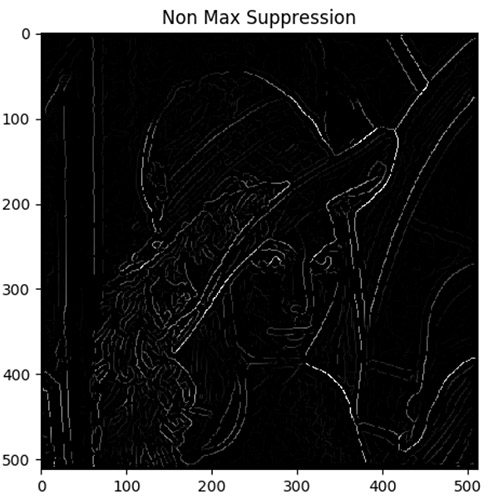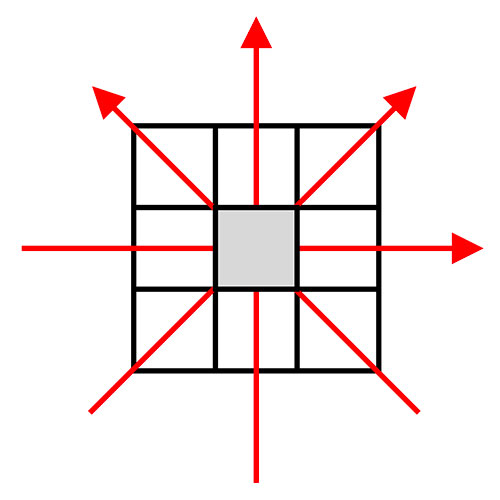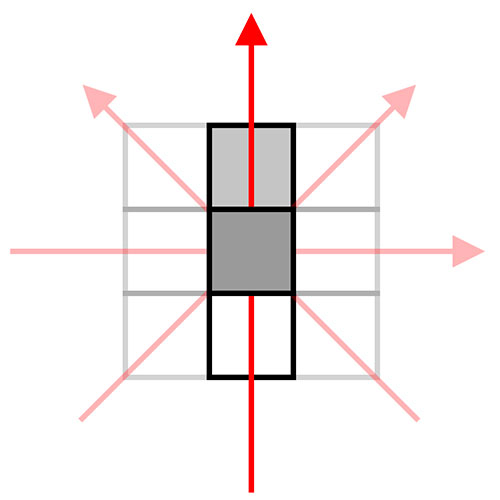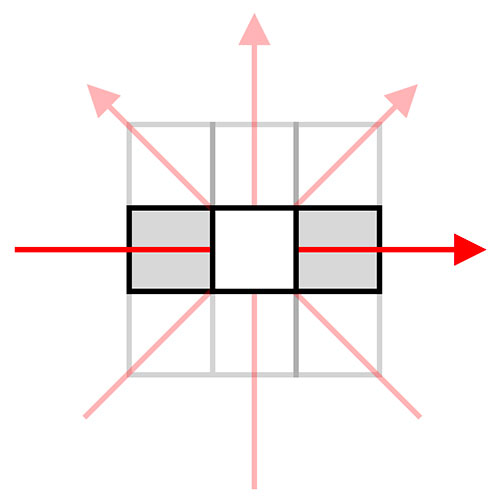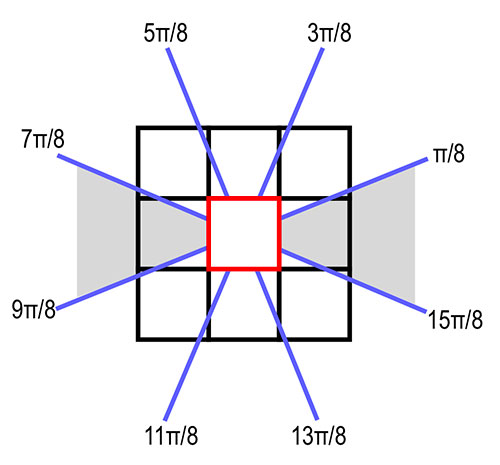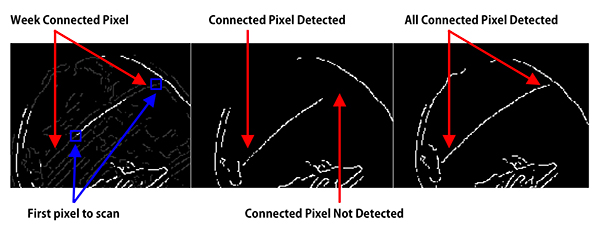Implement Canny edge detector using Python from scratch
Canny edge detector is the most widely used edge detector in Computer Vision, hence understanding and implementing it will be very important for any CV Engineer. In this tutorial we will Implement Canny Edge Detection Algorithm using Python from scratch. There are many incomplete implementation are available in GitHub, however we will understand every step and build the complete algorithm.
Canny Edge Detector Steps
- Smooth image with Gaussian Noise.
- Find magnitude and orientation of gradient.
- Apply Non-max suppression.
- Apply Hysteresis threshold.
Smooth image with Gaussian Noise
I have already posted tutorial on this. Please refer it here
Find magnitude and orientation of gradient
I also have a tutorial on calculating the magnitude of the gradient. Please refer it here
Orientation of Gradient
We will update our sobel_edge_detection() function to calculate the Orientation of Gradient.
1
2
def sobel_edge_detection(image, filter, convert_to_degree=False, verbose=False):
...
First we will add another argument to the function named convert_to_degree.
The equation for calculating the Orientation of Gradient is:
\[\theta = tan^{-1} \bigg( \frac{G_x}{G_y} \bigg)\]1
2
3
4
5
6
7
gradient_direction = np.arctan2(new_image_y, new_image_x)
if convert_to_degree:
gradient_direction = np.rad2deg(gradient_direction)
gradient_direction += 180
return gradient_magnitude, gradient_direction
Use the Numpy’s arctan2() function to calculate the gradient direction. However the returned value will be in radian. If the convert_to_degree is set to True then we will convert it to degree by calling the rad2deg() function. This returns the degree between -180 to 180 , which we will convert from 0 to 360 by adding 180 to gradient_direction .
Finally we will return both the magnitude and direction of gradient.
As you have seen already we can plot the Gradient Magnitude.
Apply Non-max Suppression
This is probably the most important step in Canny Edge Detection Algorithm. We have two different parameters
- Magnitude of the Gradient
- Direction of the Gradient
Our objective is to remove redundant/duplicate edges identified by Sobel Edge Detection ( Refer the image above ). We want just one line to show the edge rather than having multiple lines for the same edge. This can be done by the Non-Max Suppression Algorithm.
A pixel can have total 4 directions for the gradient (shown below) since there are total 8 neighboring pixels.
We want to make sure no adjacent pixels are representing the same edge and in order to do that, we want to compare the Magnitude of the gradient between one pixel and it’s neighboring pixels along the same direction and select the pixel whose magnitude is the largest. Let’s understand that in more detail.
We will start with a black image where all pixel values are zero.
Now, consider the following example. We have a pixel (middle one) who’s gradient’s direction is 90 degree. Hence we will compare the magnitude of the gradient with both the pixel above (90 Degree) and below (270 Degree) it. Now in this example white represents higher value (255) and black represents lower value (0). We can see that the bottom pixel has higher value than the one we are comparing with. Hence we won’t take the value of the selected pixel. Since we started with a black image, the value of this this pixel will remain 0.
Here is another example, say the gradient direction of a given pixel is 0 degree. So we will compare the magnitude of gradient of the right ( 0 degree ) and left ( 180 degree ) pixel with it. In this example, clearly the magnitude of gradient of the selected pixel is higher than the other two, hence we update our output pixel value by the magnitude of gradient of the selected pixel.
We will repeat this for all the pixel except the boarding pixel of the image. The output will look like following:
There is one more concept to go through before we jump into the code. In our example we have taken the direction as 90 ( or 0 ) degree, where we know we had to compare the top or bottom pixel. What about 57 Degree or 113 Degree?
In order to solve this problem, we will consider a range of degrees to select a neighbor. Look at the below picture. If the direction of the middle pixel is between (\frac{15\pi}{8}) & (\frac{\pi}{8}) and also between (\frac{7\pi}{8}) & (\frac{9\pi}{8}), then we shall compare the middle pixel with the left one right neighbor pixels.
Now let’s look at the code:
1
2
3
4
5
6
7
def non_max_suppression(gradient_magnitude, gradient_direction, verbose):
image_row, image_col = gradient_magnitude.shape
output = np.zeros(gradient_magnitude.shape)
PI = 180
Our non_max_suppression() function takes 2 arguments. The Gradient Magnitude and Direction.
Our output image will start with with a back image with the same width and height of the input image. Then we will set pi to 180 degree.
1
2
3
4
5
6
7
8
9
10
11
12
13
14
15
16
17
18
19
20
21
22
for row in range(1, image_row - 1):
for col in range(1, image_col - 1):
direction = gradient_direction[row, col]
if (0 <= direction < PI / 8) or (15 * PI / 8 <= direction <= 2 * PI):
before_pixel = gradient_magnitude[row, col - 1]
after_pixel = gradient_magnitude[row, col + 1]
elif (PI / 8 <= direction < 3 * PI / 8) or (9 * PI / 8 <= direction < 11 * PI / 8):
before_pixel = gradient_magnitude[row + 1, col - 1]
after_pixel = gradient_magnitude[row - 1, col + 1]
elif (3 * PI / 8 <= direction < 5 * PI / 8) or (11 * PI / 8 <= direction < 13 * PI / 8):
before_pixel = gradient_magnitude[row - 1, col]
after_pixel = gradient_magnitude[row + 1, col]
else:
before_pixel = gradient_magnitude[row - 1, col - 1]
after_pixel = gradient_magnitude[row + 1, col + 1]
if gradient_magnitude[row, col] >= before_pixel and gradient_magnitude[row, col] >= after_pixel:
output[row, col] = gradient_magnitude[row, col]
This loop is the main part of the algorithm. We will loop through all the pixels in the gradient directions ( except the border pixels ). Then based on the value of gradient direction we will store the gradient magnitude of the two neighboring pixel. At the end we will find out whether the selected/middle pixel has the highest gradient magnitude or not. If not we continue with the loop, otherwise update the output image for the given row and col with the value of the gradient magnitude.
Apply Hysteresis threshold
If you notice, the output after non-max suppression has few edges in bright white, however many of them are between gray to dark-gray. Again, our objective is to produce clear edges ( all the edge pixel will be 255 ). We will achieve this using Hysteresis Threshold .
We will break the concept in two parts:
- Apply thresholding
- Apply hysteresis
Apply thresholding
The main idea of thresholding, as the name suggest is to take all the edges and define them either week (some low number say 50) or strong ( white - 255 ). It will be more easy to understand when you look at the output:
1
2
3
4
5
6
7
8
9
10
11
12
13
14
15
16
17
18
19
def threshold(image, low, high, weak, verbose=False):
info_log("threshold()")
output = np.zeros(image.shape)
strong = 255
strong_row, strong_col = np.where(image >= high)
weak_row, weak_col = np.where((image <= high) & (image >= low))
output[strong_row, strong_col] = strong
output[weak_row, weak_col] = weak
if verbose:
plt.imshow(output, cmap='gray')
plt.title("threshold")
plt.show()
return output
In our threshold() function if the value of any pixel is higher than the high value, then we set it to 255. We assume these are proper edges. Next if the pixels are between low and high value then we set them to week value ( passed as an argument ). Remaining pixels will all the 0.
The function call will look like below:
1
2
3
weak = 100
new_image = threshold(new_image, 5, 20, weak=weak, verbose=args["verbose"])
Apply hysteresis
So we already have the confirmed edges in white pixel ( 255 ) and other pixels in some weak value ( say 50 ). The objective of the hysteresis function is to identify the weak pixels which can be edges and discard the remaining.
Obvious question is how to determine which pixels are part of real edges? We want to find out whether a selected pixel is connected to the already defined edge pixels, if so we can consider this pixel also to be part of an edge.The simple solution is to find out whether any given pixels neighbors ( as we have seen earlier, there will be total 8 ) has value equal to 255, if yes then change the value of the pixel to 255, otherwise discard the pixel by setting the value to 0.
1
2
3
4
5
6
7
8
9
10
11
12
13
14
15
def hysteresis(image, weak):
image_row, image_col = image.shape
top_to_bottom = image.copy()
for row in range(1, image_row):
for col in range(1, image_col):
if top_to_bottom[row, col] == weak:
if top_to_bottom[row, col + 1] == 255 or top_to_bottom[row, col - 1] == 255 or top_to_bottom[row - 1, col] == 255 or top_to_bottom[
row + 1, col] == 255 or top_to_bottom[
row - 1, col - 1] == 255 or top_to_bottom[row + 1, col - 1] == 255 or top_to_bottom[row - 1, col + 1] == 255 or top_to_bottom[
row + 1, col + 1] == 255:
top_to_bottom[row, col] = 255
else:
top_to_bottom[row, col] = 0
We will loop through each pixel in the image, if the value of the pixel is weak (we have to do this only for weak pixels) and verify whether there are any neighboring pixel with value 255. If not then set the value of the pixel to 0.
Many of the tutorials available online implements hysteresis partially. The above code detects connected edges only if the weak pixels are after the strong pixels. Let’s look at an example.
The thresholding output has a circular edge in the hat, where the middle part contains strong pixels, left and right side have weak pixels. As per hysteresis algorithm the entire edge should have been selected since its connected and continuous.
However if we implement just algorithm we have learned so far, the left part of the edge will be detected but not the right part ( 2nd Image ). This is because we are scanning from left-top to bottom-down. When we arrive at the a pixel at the right top corner of the edge right weak edge, there are no neighboring pixels with the value 255, hence its been set to 0. However that’s not true when we arrive at the first pixel of the left weak edge (blue arrow).
In order to fix the problem, we need to also scan the image from bottom-right to top-left corner, which will help to detect the right part of the edge. ( 3rd image on top ). We will do this total 4 times from all corners.
1
2
3
4
5
6
7
8
9
10
11
12
13
14
15
16
17
18
19
20
21
22
23
24
25
26
27
28
29
30
31
32
33
34
35
36
37
38
bottom_to_top = image.copy()
for row in range(image_row - 1, 0, -1):
for col in range(image_col - 1, 0, -1):
if bottom_to_top[row, col] == weak:
if bottom_to_top[row, col + 1] == 255 or bottom_to_top[row, col - 1] == 255 or bottom_to_top[row - 1, col] == 255 or bottom_to_top[
row + 1, col] == 255 or bottom_to_top[
row - 1, col - 1] == 255 or bottom_to_top[row + 1, col - 1] == 255 or bottom_to_top[row - 1, col + 1] == 255 or bottom_to_top[
row + 1, col + 1] == 255:
bottom_to_top[row, col] = 255
else:
bottom_to_top[row, col] = 0
right_to_left = image.copy()
for row in range(1, image_row):
for col in range(image_col - 1, 0, -1):
if right_to_left[row, col] == weak:
if right_to_left[row, col + 1] == 255 or right_to_left[row, col - 1] == 255 or right_to_left[row - 1, col] == 255 or right_to_left[
row + 1, col] == 255 or right_to_left[
row - 1, col - 1] == 255 or right_to_left[row + 1, col - 1] == 255 or right_to_left[row - 1, col + 1] == 255 or right_to_left[
row + 1, col + 1] == 255:
right_to_left[row, col] = 255
else:
right_to_left[row, col] = 0
left_to_right = image.copy()
for row in range(image_row - 1, 0, -1):
for col in range(1, image_col):
if left_to_right[row, col] == weak:
if left_to_right[row, col + 1] == 255 or left_to_right[row, col - 1] == 255 or left_to_right[row - 1, col] == 255 or left_to_right[
row + 1, col] == 255 or left_to_right[
row - 1, col - 1] == 255 or left_to_right[row + 1, col - 1] == 255 or left_to_right[row - 1, col + 1] == 255 or left_to_right[
row + 1, col + 1] == 255:
left_to_right[row, col] = 255
else:
left_to_right[row, col] = 0
Sum all the pixels to create our final image. The white pixels will add up, hence to make sure there is no pixel value greater than 255, we threshold them to 255. Return the final_image .
1
2
3
4
5
final_image = top_to_bottom + bottom_to_top + right_to_left + left_to_right
final_image[final_image > 255] = 255
return final_image
The output will look like:
Full Code
1
2
3
4
5
6
7
8
9
10
11
12
13
14
15
16
17
18
19
20
21
22
23
24
25
26
27
28
29
30
31
32
33
34
35
36
37
38
39
40
41
42
43
44
45
46
47
48
49
50
51
52
53
54
55
56
57
58
59
60
61
62
63
64
65
66
67
68
69
70
71
72
73
74
75
76
77
78
79
80
81
82
83
84
85
86
87
88
89
90
91
92
93
94
95
96
97
98
99
100
101
102
103
104
105
106
107
108
109
110
111
112
113
114
115
116
117
118
119
120
121
122
123
124
125
126
127
128
129
130
131
132
133
134
135
136
137
138
139
140
141
142
143
144
145
146
147
148
149
150
151
152
153
154
import numpy as np
import cv2
import argparse
from Computer_Vision.Canny_Edge_Detection.sobel import sobel_edge_detection
from Computer_Vision.Canny_Edge_Detection.gaussian_smoothing import gaussian_blur
import matplotlib.pyplot as plt
def non_max_suppression(gradient_magnitude, gradient_direction, verbose):
image_row, image_col = gradient_magnitude.shape
output = np.zeros(gradient_magnitude.shape)
PI = 180
for row in range(1, image_row - 1):
for col in range(1, image_col - 1):
direction = gradient_direction[row, col]
if (0 <= direction < PI / 8) or (15 * PI / 8 <= direction <= 2 * PI):
before_pixel = gradient_magnitude[row, col - 1]
after_pixel = gradient_magnitude[row, col + 1]
elif (PI / 8 <= direction < 3 * PI / 8) or (9 * PI / 8 <= direction < 11 * PI / 8):
before_pixel = gradient_magnitude[row + 1, col - 1]
after_pixel = gradient_magnitude[row - 1, col + 1]
elif (3 * PI / 8 <= direction < 5 * PI / 8) or (11 * PI / 8 <= direction < 13 * PI / 8):
before_pixel = gradient_magnitude[row - 1, col]
after_pixel = gradient_magnitude[row + 1, col]
else:
before_pixel = gradient_magnitude[row - 1, col - 1]
after_pixel = gradient_magnitude[row + 1, col + 1]
if gradient_magnitude[row, col] >= before_pixel and gradient_magnitude[row, col] >= after_pixel:
output[row, col] = gradient_magnitude[row, col]
if verbose:
plt.imshow(output, cmap='gray')
plt.title("Non Max Suppression")
plt.show()
return output
def threshold(image, low, high, weak, verbose=False):
output = np.zeros(image.shape)
strong = 255
strong_row, strong_col = np.where(image >= high)
weak_row, weak_col = np.where((image <= high) & (image >= low))
output[strong_row, strong_col] = strong
output[weak_row, weak_col] = weak
if verbose:
plt.imshow(output, cmap='gray')
plt.title("threshold")
plt.show()
return output
def hysteresis(image, weak):
image_row, image_col = image.shape
top_to_bottom = image.copy()
for row in range(1, image_row):
for col in range(1, image_col):
if top_to_bottom[row, col] == weak:
if top_to_bottom[row, col + 1] == 255 or top_to_bottom[row, col - 1] == 255 or top_to_bottom[row - 1, col] == 255 or top_to_bottom[
row + 1, col] == 255 or top_to_bottom[
row - 1, col - 1] == 255 or top_to_bottom[row + 1, col - 1] == 255 or top_to_bottom[row - 1, col + 1] == 255 or top_to_bottom[
row + 1, col + 1] == 255:
top_to_bottom[row, col] = 255
else:
top_to_bottom[row, col] = 0
bottom_to_top = image.copy()
for row in range(image_row - 1, 0, -1):
for col in range(image_col - 1, 0, -1):
if bottom_to_top[row, col] == weak:
if bottom_to_top[row, col + 1] == 255 or bottom_to_top[row, col - 1] == 255 or bottom_to_top[row - 1, col] == 255 or bottom_to_top[
row + 1, col] == 255 or bottom_to_top[
row - 1, col - 1] == 255 or bottom_to_top[row + 1, col - 1] == 255 or bottom_to_top[row - 1, col + 1] == 255 or bottom_to_top[
row + 1, col + 1] == 255:
bottom_to_top[row, col] = 255
else:
bottom_to_top[row, col] = 0
right_to_left = image.copy()
for row in range(1, image_row):
for col in range(image_col - 1, 0, -1):
if right_to_left[row, col] == weak:
if right_to_left[row, col + 1] == 255 or right_to_left[row, col - 1] == 255 or right_to_left[row - 1, col] == 255 or right_to_left[
row + 1, col] == 255 or right_to_left[
row - 1, col - 1] == 255 or right_to_left[row + 1, col - 1] == 255 or right_to_left[row - 1, col + 1] == 255 or right_to_left[
row + 1, col + 1] == 255:
right_to_left[row, col] = 255
else:
right_to_left[row, col] = 0
left_to_right = image.copy()
for row in range(image_row - 1, 0, -1):
for col in range(1, image_col):
if left_to_right[row, col] == weak:
if left_to_right[row, col + 1] == 255 or left_to_right[row, col - 1] == 255 or left_to_right[row - 1, col] == 255 or left_to_right[
row + 1, col] == 255 or left_to_right[
row - 1, col - 1] == 255 or left_to_right[row + 1, col - 1] == 255 or left_to_right[row - 1, col + 1] == 255 or left_to_right[
row + 1, col + 1] == 255:
left_to_right[row, col] = 255
else:
left_to_right[row, col] = 0
final_image = top_to_bottom + bottom_to_top + right_to_left + left_to_right
final_image[final_image > 255] = 255
return final_image
if __name__ == '__main__':
ap = argparse.ArgumentParser()
ap.add_argument("-i", "--image", required=True, help="Path to the image")
ap.add_argument("-v", "--verbose", type=bool, default=False, help="Path to the image")
args = vars(ap.parse_args())
image = cv2.imread(args["image"])
blurred_image = gaussian_blur(image, kernel_size=9, verbose=False)
edge_filter = np.array([[-1, 0, 1], [-2, 0, 2], [-1, 0, 1]])
gradient_magnitude, gradient_direction = sobel_edge_detection(blurred_image, edge_filter, convert_to_degree=True, verbose=args["verbose"])
new_image = non_max_suppression(gradient_magnitude, gradient_direction, verbose=args["verbose"])
weak = 50
new_image = threshold(new_image, 5, 20, weak=weak, verbose=args["verbose"])
new_image = hysteresis(new_image, weak)
plt.imshow(new_image, cmap='gray')
plt.title("Canny Edge Detector")
plt.show()
Project in Github
Please find the full project here:

